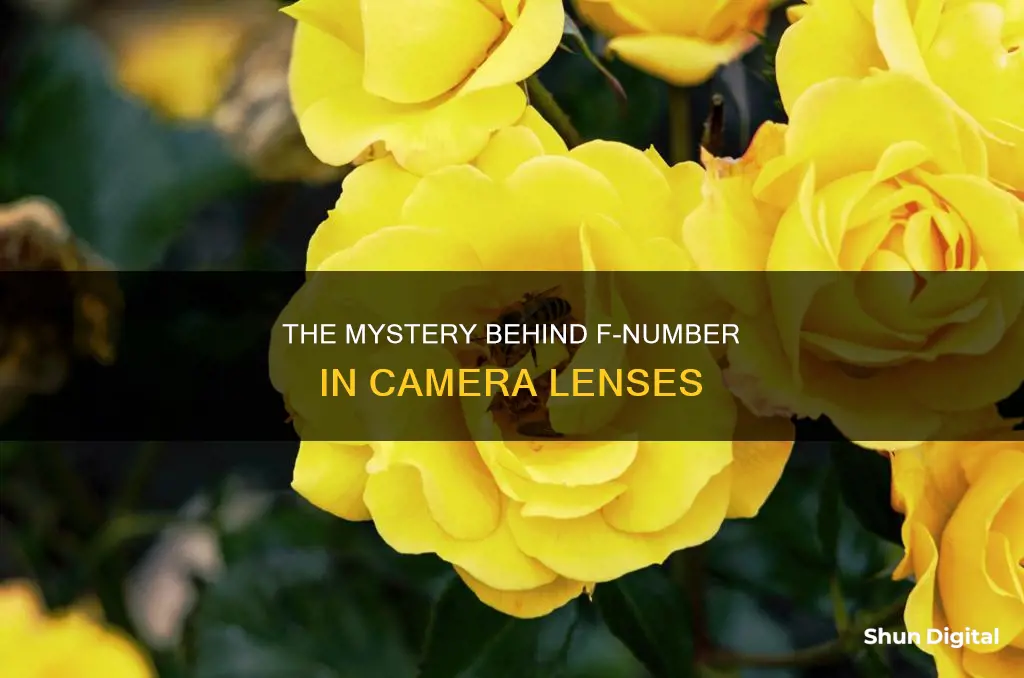
The F in camera lenses stands for Focal length. The f-number or f-stop is the ratio of the lens's focal length to its aperture diameter and indicates the amount of light coming through the lens. A lower f-number means a larger aperture and more light entering the system, while a higher f-number means a smaller aperture and less light entering the system.
| Characteristics | Values |
|---|---|
| What does the F stand for | Focal length |
| F-number | Focal ratio, f-ratio, or f-stop |
| What it indicates | Amount of light coming through the lens |
| Low F-number | Larger maximum aperture, higher light-gathering ability |
| High F-number | Smaller aperture, lower light-gathering ability |
| F-number calculation | Focal length divided by the diameter of the entrance pupil |
| F-stop | Number that the camera shows when the lens aperture size is changed |

F-number and focal ratio
The F on camera lenses stands for f-number, which is a measure of the light-gathering ability of an optical system such as a camera lens. The f-number is also known as the focal ratio, f-ratio, or f-stop. It is calculated by dividing the system's focal length by the diameter of the entrance pupil (the "clear aperture"). The f-number is usually expressed using a lower-case hooked f with the format f/N, where N is the f-number. For example, f/2.
The f-number is key in determining the depth of field, diffraction, and exposure of a photograph. A lower f-number means a larger relative aperture and more light entering the system, while a higher f-number means a smaller relative aperture and less light entering the system.
Lenses with low f-numbers are considered "fast" lenses, while those with high f-numbers are considered "slow". The f-number is also related to the numerical aperture (NA) of the system, which measures the range of angles over which light can enter or exit.
In addition to the f-number, camera lenses also have a focal length specification, which is usually denoted in millimetres. For example, a lens may have a focal length of 3.8mm. The focal length, in combination with the sensor size, determines the field of view for the lens.
In summary, the f-number and focal length are important specifications of a camera lens that affect its light-gathering ability, depth of field, exposure, and field of view.
Adjusting Camera Lenses: The Ultimate Guide to Perfect Focus
You may want to see also

Aperture size
The aperture of a camera lens is the opening through which light passes into the camera. The size of the aperture is expressed in f-numbers, also known as f-stops, which are written as fractions, e.g. f/1.4 or f/16. The f-number is not the actual size of the aperture—confusingly, it has an inverse relationship. So, a lower f-number denotes a larger aperture, and vice versa. For example, f/4 lets through twice as much light as f/8.
The aperture is one of the three pillars of photography, the other two being shutter speed and ISO. Aperture is the most important of the three because it affects not only the brightness of an image but also its depth of field. A large aperture (a low f-number) will result in a shallow depth of field, with a blurred background and a sharp subject, which is ideal for portrait photography. A small aperture (a high f-number) will keep more of the image in focus, which is ideal for landscapes and architecture photography.
The maximum aperture of a lens is usually written on the edge of the lens. For example, if the maximum aperture is 2.8, it may appear as '1:2.8', indicating that the lens can maintain a maximum aperture of f/2.8 throughout the full zoom range. A lens with a large maximum aperture is considered a 'fast' lens because it can gather a lot of light, which is ideal for low-light photography.
The Ultimate Guide to Understanding Camera Lenses Variety
You may want to see also

Focal length
A lens with a shorter focal length will have a wider field of view and lower magnification, resulting in a "zoomed-out" image. This is often referred to as a wide-angle lens. On the other hand, a lens with a longer focal length will have a narrower field of view and higher magnification, resulting in a "zoomed-in" image. This type of lens is typically called a telephoto lens.
The focal length of a lens also influences the depth of field, which is the range of distances within a scene that appears to be in focus. Lenses with shorter focal lengths tend to have greater depth of field, while longer focal lengths result in a shallower depth of field.
In addition to these effects, the focal length of a lens also plays a crucial role in determining the aperture and f-stop settings. The f-stop, or f-number, is the ratio of the lens's focal length to the diameter of the entrance pupil (aperture). This value is important because it indicates the amount of light that can pass through the lens and reach the image sensor.
A lower f-number means a larger aperture, resulting in more light entering the camera. This is often referred to as a "fast" lens. Conversely, a higher f-number means a smaller aperture, allowing less light to enter, and is known as a "slow" lens.
By adjusting the f-stop and, consequently, the aperture size, photographers can control the exposure and depth of field of their images. A larger aperture (lower f-number) will result in a shallower depth of field, which is ideal for portrait photography as it keeps the subject in focus while blurring the background. On the other hand, a smaller aperture (higher f-number) will result in a greater depth of field, making it suitable for landscape photography where both the foreground and background need to be in focus.
In summary, the focal length of a camera lens is a fundamental specification that influences the image produced. It affects the magnification, field of view, depth of field, and the amount of light that reaches the image sensor. By adjusting the f-stop and aperture based on the focal length, photographers can achieve their desired photographic effects.
Anti-Fog for Camera Lenses: Cat Crap's Effectiveness
You may want to see also

Exposure
The f-number, or f-stop, is a measure of the light-gathering ability of a camera lens. It is calculated by dividing the lens's focal length by the diameter of the entrance pupil (or aperture).
The f-number is key in determining the exposure, depth of field, and diffraction of a photograph. A lower f-number means a larger aperture and more light entering the camera, while a higher f-number means a smaller aperture and less light entering the camera.
The f-number is usually expressed using a lower-case hooked f with the format f/N, where N is the f-number. For example, f/2.8 or f/16. A lower f-number, such as f/2.8, lets in more light and is considered a "large" aperture, while a higher f-number, such as f/16, lets in less light and is considered a "small" aperture.
The f-stop setting on a camera lens can be adjusted to control the amount of light entering the camera and the depth of field of the image. A larger aperture (low f-number) will result in a shallow depth of field, with only a thin slice of the image appearing sharp. This is often used in portrait photography to blur the background and bring focus to the subject. On the other hand, a smaller aperture (high f-number) will result in a larger depth of field, with more of the image appearing sharp, and is often used in landscape photography.
In addition to controlling exposure and depth of field, the f-stop setting can also affect other aspects of a photograph, such as diffraction, sunstars, and lens aberrations. However, exposure and depth of field are typically the most important factors to consider when adjusting the f-stop.
Cleaning Camera Gear: Rubberized Coating Care
You may want to see also

Depth of field
The f-number on a camera lens stands for the measure of the light-gathering ability of the lens. It is calculated by dividing the focal length of the lens by the diameter of the entrance pupil. The f-number is also known as the focal ratio, f-ratio, or f-stop.
The f-number is key in determining the depth of field of a photograph. The depth of field is the zone within a photo that appears acceptably sharp and in focus. The size of this zone of sharpness will vary from photo to photo depending on different factors, such as the lens's aperture setting and distance to the subject.
Aperture refers to the hole in the lens through which light enters the camera. The larger the hole, the shallower the depth of field. You may be familiar with f-stop values, which look like this: f/2, f/2.8, f/4, f/5.6, f/8, f/11, f/16, etc. The smallest f-numbers correspond to the widest apertures and therefore the shallowest depths of field. And the larger f-numbers correspond to the narrowest apertures and therefore the deepest depths of field.
Large aperture = Small f-number = Shallow (small) depth of field
Small aperture = Large f-number = Deep (large) depth of field
Adjusting the aperture (f-stop) of the lens is the simplest way to control the depth of field while setting up a shot.
Choosing the Right Camera Lenses: A Beginner's Guide
You may want to see also
Frequently asked questions
The "F" in "F-stop" stands for focal length.
An F-stop is a ratio of a lens's focal length to its aperture diameter, and it indicates the amount of light coming through the lens.
The F-stop primarily influences exposure, though the effect depends on the exposure mode you're using. It also affects the depth of field, or the range within a scene that appears in focus.
A "large" F-stop like f/1.4 or f/2 is actually a larger aperture that lets in more light. A "small" F-stop like f/16 or f/22 is a smaller aperture that lets in less light.







